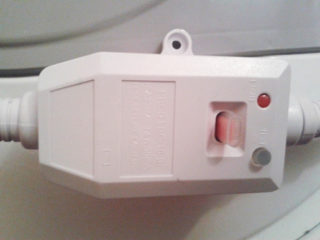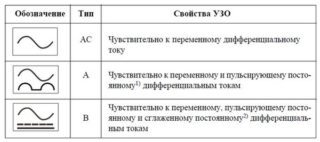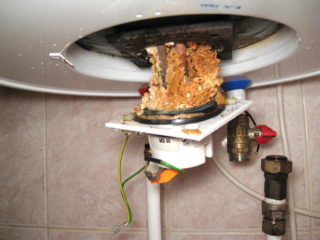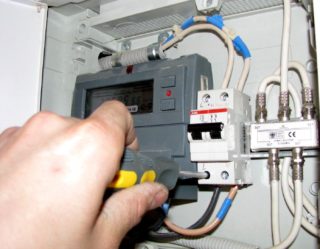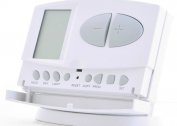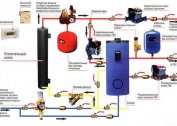Flowing and storage boilers are equipped with protective shutdown devices to protect against human electric shock and prevent breakdowns. When the home network is overloaded, wiring problems, an RCD is knocked out on the water heater. The malfunction can be detected and eliminated independently.
Features of the operation, selection and connection of RCD
The protection device is necessary to de-energize the power line in the presence of short circuits and current leaks. The device operates by comparing the parameters of the incoming and outgoing current. With a difference of 30 mA, the circuit is automatically opened. A person touching the enclosure of an equipment cannot be injured.
Safety Instrument Requirements
The safety device for the water heater must meet the following criteria:
- Power. The indicator depends on the power rating of the home network and the number of phases.
- Voltage on power lines. Single-phase models are suitable for heaters connected to a 220 V network, three-phase models are suitable for a 380 V network.
- Degree of protection. Optimal models for the apartment - with a shutdown in case of leakage of 30 mA.
- Place of installation. For an apartment boiler or heater in a private house, modifications marked C16 and C25 are suitable
- Class. Class A RCDs are suitable for equipment with high energy consumption. AC class models often burn out.
Installation of the device is carried out in the socket or switchboard. In the latter case, a three-core copper cable is used. Since the heater is a high-power technique, you will need to ground the outlet.
Classification of residual current devices
A high-quality device provides disconnection of consumers under voltage, controls the transmittance of the rated current, de-energizes the circuit when the input and output current difference. Manufacturers produce a wide range of devices with various characteristics, based on which they are divided into several types.
Household and power traction voltage
Depending on the conditions in which the RCD will operate, you can choose the types:
- AC - reacts to sudden or slowly increasing changes in the alternating differential sinusoidal current.
- A - triggered by a sudden increase or a slow increase in the parameters of an alternating sinusoidal and pulsating constant differential currents.
- B - turns off when changes in AC, rectified, direct current.
- S and G are selective instruments equipped with a shutdown time delay mode.
Electromechanically controlled models are not tied to the supply voltage. The signal for them is the differential current. Electronic options are powered by a power line or other source.
By the number of poles
Depending on the characteristics of the electrical network, you can choose an RCD:
- 2P, or bipolar. Suitable for single phase line. Equipped with 4 paired terminals on each side for popping up on neutral and phase.
- 4P, or four-pole. Suitable for three-phase and single-phase networks. On each side of the device there are 3 terminals for phases and one for connecting the neutral.
The RCD compares currents, so the number of poles must match the number of conductors.
Rated current
The indicator should be equal to or greater than the total rating of the circuit breakers for the groups. Modifications for 6000 A are suitable for domestic use, but with a new house and a transformer station, 10 kA RCDs are placed near the input.
Differential current
Optimal devices for the protection of humans and animals will be triggered by a differential current of 30 mA. Switches operating at currents from 100 mA are used for fire-fighting purposes - they completely de-energize the line.
Installation of devices is carried out on a wall, on a din-rail. There are devices that have the design of carriers, adapters, sockets.
The main and additional causes of operation
If the boiler knocks out an automatic machine, the reasons most often are as follows:
- Damage to the insulation of electrical models with heating elements. The protective layer is destroyed by contact of water with conductive nodes. To check the part, it will need to be removed from the tank and inspected. Cracks indicate that the heater needs to be replaced.
- Current leakage. Occur when connecting a water heater to an old wiring, cable with exposed conductors, mechanical damage to the insulation and installation errors.
- Shorting the bare cable to the housing. When the bare core comes into contact with the housing, the machine will be switched off permanently. The phenomenon leads to electric shock.
- RCD mismatch with voltage and power parameters. Knocking out is periodic - the device simply can not cope with the load.
- Malfunction of the device itself. The main reasons are the wear of the start mechanism or the lowering of the test key.
Often shutdown occurs after heating the water. The malfunction occurs in boilers with deformed bodies in contact with the phase.
Why the RCD of Termeks boilers works
Termex instantaneous and storage type water heaters are popular because of the ease of connection, tank capacity, good power and low cost. When an RCD trips during operation, it is possible that there is a damage to the Termex brand water heater or a faulty power supply:
- Breakdown of the body. In the presence of grounding the device will work immediately.
- A break in the wiring in the room. Most often, the neutral is damaged.
- Mechanical damage to the heater. The heater spiral is in contact with water in the presence of a constant scale.
- Contact between housing and phase. Shutdown occurs after heating the water.
- The land line of the riser is thrown to zero network. If the boiler starts, there are risks of injury.
- Malfunction of the RCD itself. Chinese complete devices often fail. They need to be changed.
- Exceeding the load rating. When the boiler, stove and iron are turned on at once, protection against network overloads is activated.
Boilers are only installed with a ground line.
Features of repair and replacement of RCD
If the machine knocks out when the boiler is turned on, the probability of breakage is high. It is possible to repair a faulty RCD if you have experience, tools and parts. The optimal solution for the owners is to replace the device. To determine its probability, a monthly check is required. To do this, use the button to create an artificial leak.
The nuances of repair work
The complexity of the repair is the lack of a scheme. Therefore, in self-troubleshooting, you should be guided by the following algorithm:
- Removing sealant and screws on the body.
- Removing fasteners with a slotted screwdriver and disassembling the device.
- Making a circuit by sketching from a printed circuit board.
- Device testing. The leakage current is simulated by applying voltage from a resistor to an amplifier. Leakage is indicated by triac activation and circuit closure.
- Troubleshooting and assembly.
To connect a water heater in order to protect against leaks, overloads, short circuits, it is necessary through an RCD or an automatic machine.
Knocking out the protective shutdown device for boilers occurs for several reasons. Breakage can be detected independently.Since the RCD is not equipped with a circuit and is a complex device, it is easier to replace it than to repair it.
